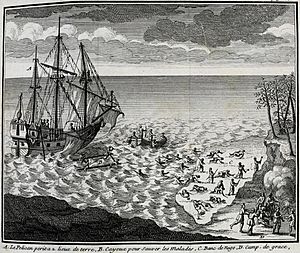Battle of Hudson's Bay facts for kids
Quick facts for kids Battle of Hudson's Bay |
|||||||
|---|---|---|---|---|---|---|---|
| Part of King William's War | |||||||
 The Sinking of the Pélican, Bacqueville de la Potherie |
|||||||
|
|||||||
| Belligerents | |||||||
| Commanders and leaders | |||||||
| Strength | |||||||
| 1 ship of the line | 1 ship of the line 2 frigates |
||||||
| Casualties and losses | |||||||
| 1 ship of the line scuttled | 1 ship of the line destroyed 1 frigate captured |
||||||
The Battle of Hudson's Bay, also called the Battle of York Factory, was an important sea fight. It happened on September 5, 1697, during a big war known as the Nine Years' War in Europe. In North America, this war was called "King William's War."
During this battle, a French warship led by Pierre Le Moyne d'Iberville faced off against an English fleet. The English fleet was commanded by Captain John Fletcher. The French ship won this battle. After their victory, the French were able to take over York Factory. This was a valuable fur trading post belonging to the Hudson's Bay Company.
Contents
Why the Battle Happened
During King William's War, France wanted to control the fur trade in Hudson Bay. They sent forces many times to capture or destroy the English forts there. In 1690, a French commander named Pierre Le Moyne d'Iberville tried to attack. However, a larger English ship forced him to leave.
D'Iberville returned in 1694 and successfully captured York Factory. He renamed it Fort Bourbon. But the next year, English naval forces came back. They took the fort from the small French group guarding it.
In 1697, D'Iberville was given command of a French squadron. His main ship was the Pélican, which had 44 cannons. This group of ships was sent to challenge England's control of Hudson Bay.
The French Fleet
D'Iberville's ship, Le Pélican, was a powerful warship. It was designed to carry 50 cannons and had 150 sailors. Other ships were supposed to join Le Pélican. These included Le Profond, a supply ship with 32 cannons. There was also Le Vesp, a frigate with 20-26 guns. Another frigate, Le Palmier, also had 20-26 guns. A small supply ship called L'Esquimau was also part of the fleet.
D'Iberville's Surprise Encounter
Before the battle, a thick fog separated Pélican from the other French ships. D'Iberville decided to sail ahead alone. This led to a very unusual battle where one ship fought against many.

As Pélican sailed closer to York Factory, the weather cleared. A small group of French soldiers went ashore to check out the fort. Captain D'Iberville stayed on his ship. While waiting, he saw the sails of approaching ships. He thought they were the rest of his French fleet.
However, D'Iberville soon realized his mistake. One of the ships fired a warning shot at Le Pélican. He then knew these were English ships, not his own.
The English Fleet
The English fleet was made up of three ships. The main warship was Hampshire, commanded by Captain Fletcher. It had 50 cannons, just like Pélican. The other two ships belonged to the Hudson's Bay Company. These were the Royal Hudson's Bay, with 32 cannons, and the Dering, with 36 cannons. Another English ship, a fireship called HMS Owner's Love, had been crushed by ice earlier.
The Battle Begins
D'Iberville's shore party was too far away to help. So, he chose to fight the English fleet alone. The battle started with both sides firing as they moved. After about two and a half hours, D'Iberville brought Pélican very close to the English ships.
A fierce fight began between Pélican and Hampshire. Both ships fired their cannons at each other from close range. It seemed like the English were winning. Blood was even flowing from Pélican's drainage holes into the water. Captain Fletcher of Hampshire demanded that D'Iberville surrender. But D'Iberville bravely refused.
It is said that Captain Fletcher raised a glass of wine to toast D'Iberville's courage. At that very moment, Pélican fired another broadside (all its cannons at once). This shot hit Hampshire's powder room. The Hampshire exploded and sank.
After the Battle
The other two English ships, Hudson's Bay and Dering, did not play a big part in the main fight. After Hampshire exploded, Hudson's Bay was damaged. It then lowered its flag, showing it surrendered to Pélican.
The Dering decided to escape and sailed away. Pélican was too badly damaged to chase it.
Pélican itself was also severely damaged in the battle. It had holes below the waterline and had to be abandoned. Luckily, the rest of the French squadron arrived shortly after. This allowed the French to capture York Factory on September 13, 1697. This victory was another highlight in D'Iberville's impressive career.
The French held York Factory until 1713. It was then given back to the British as part of the Peace of Utrecht treaty.
See also
 In Spanish: Batalla de la bahía de Hudson para niños
In Spanish: Batalla de la bahía de Hudson para niños


